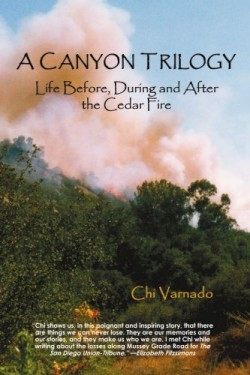A Canyon Trilogy
Life Before, During and After the Cedar Fire
“It seems like no job can be completed by the expert doing the work for there is always something unique that their work doesn’t include. So the finishing person is almost always me—choreographing some way to tie that last knot” observes ballet instructor Chi Varnado. The author shows with documentarian detail what happens when a family loses everything—even their matriarch. They eventually find a future by focusing on one successive task after another. Varnado overlooks little seeing the suffering of burned-out neighbors the arbitrary red tape of building permit authorities and recording the incredible generosity of friends and strangers in the wake of a disaster. At her mother’s funeral the memoirist notes “…I’m a little like a video camera myself…”
This account of death destruction and triumphant rebuilding opens with word that a massive fire threatens to sweep into a canyon outside San Diego in the fall of 2003. With urgency the dance instructor and her husband round up their children most (but not all) of their animals and not nearly enough precious keepsakes for a hurried evacuation. The fire itself is a merciless antagonist eventually decimating more than four hundred square miles including five homes of extended family. Disease and the threat of losing hope form other arms of the opposition and a besieging Fire Marshal (referred to as “The Gestapo”) helps the memoirist’s family use up their already inadequate insurance settlement with no guarantee that he’ll allow them to finish construction.
Honesty is the narrative’s guiding value. Varnado’s mother nicknamed “Gramaset” is portrayed as hardworking handy with carpentry in tune with animals hopelessly unconcerned with housekeeping and prone to unbridled favoritism among children and grandchildren. The memoirist comes close to becoming bogged down with melancholy during the chapters of Gramaset’s fight with brain cancer a pre-fire struggle which is presented out of chronology. She looks back at what most Americans would consider an unconventional (though fairly idyllic) childhood. Not many kindergartners have to be warned not to mention that they live at a nudist colony.
Varnado acknowledges that she preferred to maintain emotional reserve before the fire forced her to change. She’s a doer who excels at task-oriented enterprises but is partially crippled when navigating through emotionally charged relationships. Because of this the second half of the book which deals literally with the rise from ashes holds together quite nicely.
A committed crew of log home builders Wyoming men who like red meat fast cars and possibly even Republican politicians earn Varnado’s respect. By the time her house is complete her social circle has broadened her tolerance has increased and no undertaking seems impossible anymore. On the way back from shattering defeats she learns to see value in all sorts of incremental positives.
A Canyon Trilogy opens fast closes with quiet strength and bustles with a cast of eccentric characters. Here is a person who does all she can herself learning how to reach out when the challenges become tremendous.
Disclosure: This article is not an endorsement, but a review. The publisher of this book provided free copies of the book and paid a small fee to have their book reviewed by a professional reviewer. Foreword Reviews and Clarion Reviews make no guarantee that the publisher will receive a positive review. Foreword Magazine, Inc. is disclosing this in accordance with the Federal Trade Commission’s 16 CFR, Part 255.

